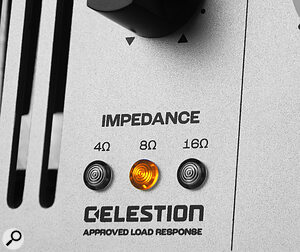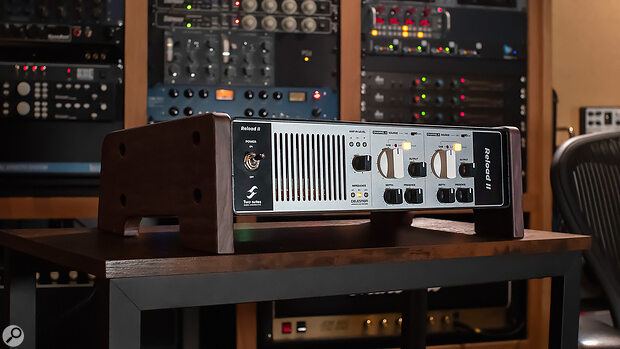French company Two notes Audio Engineering have updated their flagship Reload re‑amping product — and it’s different from what everybody was expecting!
I’m sure I wasn’t alone in feeling certain that Two notes would integrate their premium tube‑amp loading and re‑amping device with their renowned speaker and mic simulation software — it would make a product that competed directly with units like UA’s OX and the Boss Tube Amp Expander. But, apparently, we were wrong. The new Reload II is still a dedicated reactive dummy load and re‑amping power amp, albeit one that ships with an included perpetual licence for Two notes’ excellent Genome Reload II Edition speaker and mic emulation software. But if you’re one of those people who is disappointed about what it doesn’t do, you certainly won’t be disappointed with what it actually does. It looks to me like Two notes have set out to make the Reload II the most complete, most versatile and, above all, best‑sounding re‑amping unit on the market. And I think they’ve succeeded...
‘Celestion Approved’
 In order to work with a wide range of virtual speakers, the Reload II’s ‘Celestion approved’ impedance curve seems not to emulate one particular speaker type.Two notes refer to a “ground‑up rework” of their reactive load, described now as a “Celestion‑Approved Load Response”, seeking to replicate as closely as possible the impedance curve of a typical loudspeaker, thereby maintaining the normal tonal and dynamic response of the connected amp. With the advent of increasing numbers of devices designed for the safe loading and silent DI recording of tube amps, the term ‘impedance curve’ has gone from being something guitar players simply never thought about to being the source of seemingly never‑ending heated debate, with the role of the ‘reactive load’ at the heart of such units coming under particular scrutiny.
In order to work with a wide range of virtual speakers, the Reload II’s ‘Celestion approved’ impedance curve seems not to emulate one particular speaker type.Two notes refer to a “ground‑up rework” of their reactive load, described now as a “Celestion‑Approved Load Response”, seeking to replicate as closely as possible the impedance curve of a typical loudspeaker, thereby maintaining the normal tonal and dynamic response of the connected amp. With the advent of increasing numbers of devices designed for the safe loading and silent DI recording of tube amps, the term ‘impedance curve’ has gone from being something guitar players simply never thought about to being the source of seemingly never‑ending heated debate, with the role of the ‘reactive load’ at the heart of such units coming under particular scrutiny.
Nobody would dispute that having an accurately speaker‑like impedance curve is a good thing in a dummy load — that much is obvious — but there is a little more to it than that. Units like UA’s OX (and Two notes’ Captor X for that matter) have fairly ‘generic’ impedance curves, and yet nobody could argue that they aren’t capable of producing a line‑level signal that, for recording or PA purposes, sounds convincingly like a miked‑up speaker. Obviously, the dynamic modelling, or the IR and other processing, is designed to do a significant amount of the work in those cases, especially when you consider the possible need to emulate the response of a number of different speakers and mics. Indeed, it could be argued that having the exact impedance curve of, say, Greenbacks in a 4x12 may not help that much when you are trying to emulate a 1x12 JBL in an open‑back combo cab. Not only would the speakers themselves be quite different, but even the enclosure would be affecting the reflected load behaviour of the system as a whole. Logically, therefore, the ‘Celestion Approved’ tag in the Reload II undoubtedly means this reactive load’s impedance curve doesn’t emulate just one specific speaker type.
Touch &...
You are reading one of the locked Subscribers-only articles from our latest 5 issues.
You've read 30% of this article for FREE, so to continue reading...
- ✅ Log in - if you have a Digital Subscription you bought from SoundOnSound.com
- ⬇️ Buy & Download this Single Article in PDF format £0.83 GBP$1.49 USD
For less than the price of a coffee, buy now and immediately download to your computer, tablet or mobile. - ⬇️ ⬇️ ⬇️ Buy & Download the FULL ISSUE PDF
Our 'full SOS magazine' for smartphone/tablet/computer. More info... - 📲 Buy a DIGITAL subscription (or 📖 📲 Print + Digital sub)
Instantly unlock ALL Premium web articles! We often release online-only content.
Visit our ShopStore.

